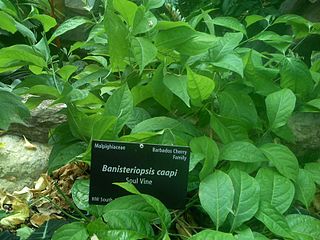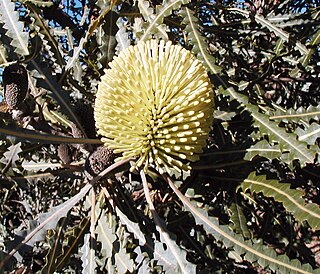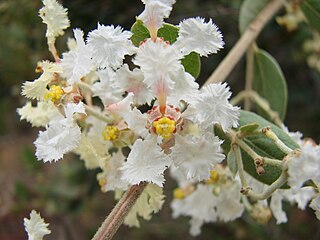
Ayahuasca is a South American entheogenic brew commonly made out of the Banisteriopsis caapi vine, and the Psychotria viridis shrub or a substitute, and possibly other ingredients; although, a chemically similar preparation, sometimes called "pharmahuasca", can be prepared using N,N-Dimethyltryptamine (DMT) and a pharmaceutical monoamine oxidase inhibitor (MAOI) such as isocarboxazid. The brew is used as a traditional spiritual medicine in ceremonies among the indigenous peoples of the Amazon basin.

Zinnia is a genus of plants of the sunflower tribe within the daisy family (Asteraceae). They are native to scrub and dry grassland in an area stretching from the Southwestern United States to South America, with a centre of diversity in Mexico. Members of the genus are notable for their solitary long-stemmed flowers that come in a variety of bright colors. The genus name honors German master botanist Johann Gottfried Zinn (1727–59).

Cryptomeria is a monotypic genus of conifer in the cypress family Cupressaceae, formerly belonging to the family Taxodiaceae. It includes only one species, Cryptomeria japonica. It used to be considered by some to be endemic to Japan, where it is known as Sugi. The tree is called Japanese cedar or Japanese redwood in English. It has been extensively introduced and cultivated for wood production on the Azores.

Banisteriopsis caapi, also known as ayahuasca, jagube, caapi or yagé, is a South American liana of the family Malpighiaceae. It is one half of ayahuasca, a decoction with a long history of its entheogenic (hallucinogenic) use and its status as a "plant teacher" among the Indigenous peoples of the Amazon rainforest.

Anadenanthera peregrina, also known as yopo, jopo, cohoba, parica or calcium tree, is a perennial tree of the genus Anadenanthera native to the Caribbean and South America. It grows up to 20 m (66 ft) tall, and has a horny bark. Its flowers are pale yellow to white and spherical. It is an entheogen which has been used in healing ceremonies and rituals for thousands of years in South America.

Several alkaloids that function as monoamine oxidase inhibitors (MAOIs) are found in the seeds of Peganum harmala, as well as tobacco leaves including harmine, harmaline, and harmalol, which are members of a group of substances with a similar chemical structure collectively known as harmala alkaloids. These alkaloids are of interest for their use in Amazonian shamanism, where they are derived from other plants. The harmala alkaloid harmine, once known as telepathine and banisterine, is a naturally occurring beta-carboline alkaloid that is structurally related to harmaline, and also found in the vine Banisteriopsis caapi. Tetrahydroharmine is also found in B. caapi and P. harmala. Dr. Alexander Shulgin has suggested that harmine may be a breakdown product of harmaline. Harmine and harmaline are reversible MAOIs of the MAO-A isoform of the enzyme, and can stimulate the central nervous system by inhibiting the metabolism of monoamine compounds such as serotonin and norepinephrine.
Harmine is a beta-carboline and a harmala alkaloid. It occurs in a number of different plants, most notably the Syrian rue and Banisteriopsis caapi. Harmine reversibly inhibits monoamine oxidase A (MAO-A), an enzyme which breaks down monoamines, making it a RIMA. Harmine does not inhibit MAO-B. Harmine is also known as banisterine, telepathine, leucoharmine and yageine.

Harmaline is a fluorescent indole alkaloid from the group of harmala alkaloids and beta-carbolines. It is the partially hydrogenated form of harmine.
The Beneficent Spiritist Center União do Vegetal is a religious society founded on July 22, 1961 by José Gabriel da Costa, known as Mestre Gabriel. The UDV seeks to promote peace and to "work for the evolution of the human being in the sense of his or her spiritual development", as is written in its bylaws. The institution today has over 18,000 members, distributed among more than 200 local chapters located in all the states of Brazil, as well as in Peru, Australia, several countries in Europe, and the United States. The translation of União do Vegetal is Union of the Plants referring to the sacrament of the UDV, hoasca tea, also known as ayahuasca. This beverage is made by boiling two plants, mariri and chacrona, both of which are native to the Amazon rainforest.

Malpighiaceae is a family of flowering plants in the order Malpighiales. It comprises about 73 genera and 1315 species, all of which are native to the tropics and subtropics. About 80% of the genera and 90% of the species occur in the New World and the rest in the Old World.

Banksia elegans, commonly known as the elegant banksia, is a species of woody shrub that is endemic to a relatively small area of Western Australia. Reaching 4 m (13 ft) high, it is a suckering shrub that rarely reproduces by seed. The round to oval yellow flower spikes appear in spring and summer. Swiss botanist Carl Meissner described Banksia elegans in 1856. It is most closely related to the three species in the subgenus Isostylis.

Hiptage benghalensis, often simply called hiptage, is a perennial, evergreen liana native to India, Southeast Asia and the Philippines. Its habitat is variable and prefers climates ranging from warm temperate to tropical. In Hawaii, where H. benghalensis is considered a weed, as it is in Australia, Mauritius and Réunion, it grows from sea level to 1,000 m (3,281 ft). H. benghalensis is cultivated for its white-pink scented flowers.

Francis Theodore Nied was a founder of the American Professional Football Association, as well as the owner of the Akron Pros and, as the team became known as in 1926, the Akron Indians.

Banisteriopsis is a genus of flowering plants in the family Malpighiaceae. There are about 92 species. Most are native to Brazil, Bolivia, Colombia, Ecuador, and Peru.
Girdhar Kumar Pandey is an Indian molecular biologist, biochemist, biotechnologist, and a professor at the department of plant molecular biology of the South Campus of the University of Delhi. he is known for his studies on the signal transduction pathways in Arabidopsis (rockcress) and Oryza sativa (rice) and is an elected fellow of the National Academy of Sciences, India and the National Academy of Agricultural Sciences. The Department of Biotechnology of the Government of India awarded him the National Bioscience Award for Career Development, one of the highest Indian science awards, for his contributions to biosciences, in 2015.
Spachea elegans is a species of flowering plants in the family Malpighiaceae. It is found in Brazil and Venezuela.











